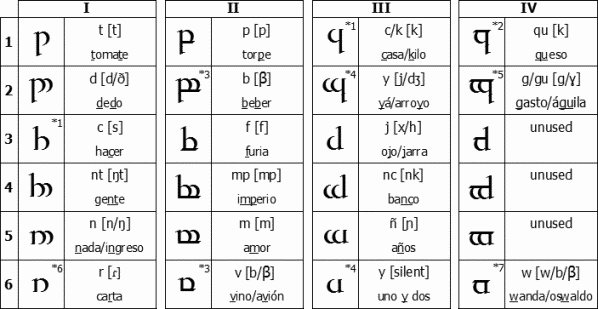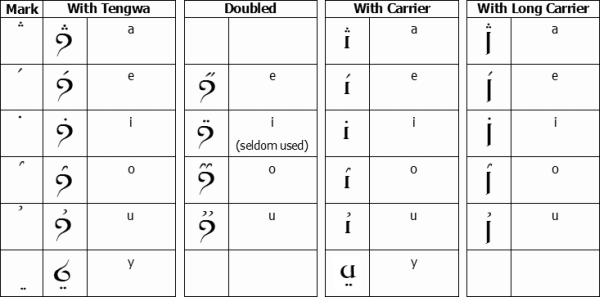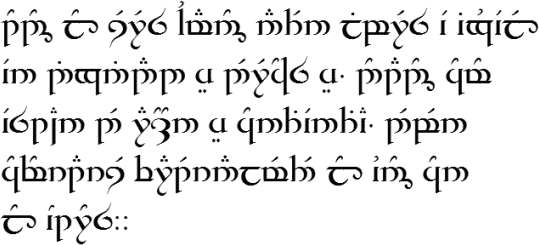Tengwar for Latin American Spanish

This is a method of writing Latin American Spanish using Tolkien's Tengwar
alphabet devised by Exelsus. He has based his method strictly on Quenya from
the third age, and believes it keeps a good balance between orthography and
pronunciation and a good compatibility with the original Quenya. With few modifications
it can also be a good method for European Spanish.
Notable features
- Type of writing system: vocalised abjad
- Direction of writing: left to right in horizontal lines
- Vowels are written with diacritics over the consonants that precede them,
or over a vowel carrier if they are at the beginning of a word or on their own.
Consonants (tengwa)



Vowels (tehtar)

Diphthongs

Notes
- 1) c: 'c' is a redundant consonant, when it preceds an a,o and u is pronounced as [k], when it
preceds e and i is pronounced as [s]. As letter 'k' is rarely used in spanish it can share the same tengwa for the [k]
sound. For the [s] sound the a the 'Súlë' tengwa is used instead of the 'Silmë' to differentiate.
- 2) qu: In spanish, 'q' is always followed by an 'u', and in that case the 'u' is silent so is grouped
in the same tengwa.
- 3) b/v: 'b' is pronounced as [ß], and ironically 'v' can be either [b] or [ß], and very seldom [v] in day to day use. In
order to preserve ortography those where assigned to different tengwas, even when 'b' is less comon than 'v'.
- 4) y: 'y' can be a consonant or a vowel. In case is a vowel in need for a carrier, the silent 'Anna' tengwa is used instead
the short carrier used for the other vowels
- 5) g: 'g' is pronounced as a [x] or [h] when it preceeds vowel e, else is pronounced as [g] or [?]. As the[x/h] sound
coincide with the letter 'j' and both are common it was better to keep them in separate tengwas. When 'gu' souds like [gu:] tough, the 'u'
has to be represented appart
- 6) r: In Quenya when an 'r' preceds a consonant, the 'Órë' tengwa is used (n shaped). When it preceds a vowel the 'Rómen'
tengwa is use (y shaped). The 'rr' can be represented by adding a bar under the 'Rómen' tengwa so it is doubled.
- 7) w: The 'w' is almost never used in spanish, only in some names, and translated words.
- 8) l: 'l' represents an [l], and 'll' represents an [j/d?], and this can be done by placing a bar under this tengwa
so it is doubled.
- 9) s: This tengwa can be represented in two ways, the downward form is tipically used (and recomended) when it contains a
tetha, although is not necesary. If this tengwa is the last in a word it can be represented as a curl
 attached to the previous letter, but this is not mandatory.
attached to the previous letter, but this is not mandatory.
- 10) z: This consonant has the same sound as 's'. In order to preserve ortography, another tengwa was used. According
to Tolkien the 'Ázë' tegwa used to sound as a [?] but in the third age it changed to [ss] which fits this purpouse. As in the previous
note, it can be represented in two ways.
- 11) h: In spanish the 'h' is silent, and is kept only for ortography. The 'Halla' tengwa was used because it lost its meaning
in the third age when the 'Hyarmen' took it's sound ([h]).
- 12) x: The 'x' letter souds as [ks]. In order to keep things simple Tolkien attached an s curl to the 'k' tengwa to make the 'x' sound.
This is the only case in tengwar when an s curl is allowed in a possition different from the end of the word.
- 13) Accents can be represented either with a long carrier, or doubling the theta above the consonant. Double vowels can also be
represented by doubling the theta above the consonant.
- 14) 'a' theta is the only vowel that can't be doubled because it takes too much room. An 'aa' shoud use a carrier.
Sample text

Transliteration
Todos los seres humanos nacen libres e iguales en dignidad y derechos
y, dotados como están de razón y conciencia, deben comportarse
fraternalmente los unos con los otros.
Translation
All human beings are born free and equal in dignity and rights. They
are endowed with reason and conscience and should act towards one another
in a spirit of brotherhood.
(Article 1 of the Universal Declaration of Human Rights)
Links
Other methods of writing Spanish with Tengwar
http://lambenor.free.fr/tengwar/espanol.html
http://djelibeibi.unex.es/tengwar/
http://neobabel.org/archivo/58
http://usuarios.lycos.es/barbol/tengwar/espanol.html
Information about Tengwar in Spanish
http://www.lacoctelera.com/adastra/post/2005/08/31/escritura-elfica-introduccion
http://es.wikipedia.org/wiki/Tengwar
http://usuarios.lycos.es/barbol/tengwar/tengwar.html
Tengwar pages: Tengwar for Quenya,
Sindarin,
Arabic,
English,
Finnish,
High Valyrian,
Hungarian,
Icelandic,
Kurdish,
Portugese,
Russian,
Scottish Gaelic (1),
Scottish Gaelic (2),
Spanish,
Spanish (Latin American),
Turkish,
Vietnamese,
Welsh
Tolkien's alphabets and languages: Cirth |
Sarati |
Tengwar for Quenya |
Tengwar for Sindarin |
Uruk Runes |
Links |
Books about Tolkien's languages |
Tolkien's books
Constructed scripts for: Ainu |
Arabic |
Chinese languages |
Dutch |
English |
Hawaiian |
Hungarian |
Japanese |
Korean |
Lingala |
Malay & Indonesian |
Persian |
Tagalog / Filipino |
Russian |
Sanskrit |
Spanish |
Taino |
Turkish |
Vietnamese |
Welsh |
Other natural languages |
Colour-based scripts |
Tactile scripts |
Phonetic/universal scripts |
Constructed scripts for constructed languages |
Adaptations of existing alphabets |
Fictional alphabets |
Magical alphabets |
A-Z index |
How to submit a constructed script
[top]

You can support this site by Buying Me A Coffee, and if you like what you see on this page, you can use the buttons below to share it with people you know.

If you like this site and find it useful, you can support it by making a donation via PayPal or Patreon, or by contributing in other ways. Omniglot is how I make my living.
Note: all links on this site to Amazon.com , Amazon.co.uk
, Amazon.co.uk and Amazon.fr
and Amazon.fr are affiliate links. This means I earn a commission if you click on any of them and buy something. So by clicking on these links you can help to support this site.
are affiliate links. This means I earn a commission if you click on any of them and buy something. So by clicking on these links you can help to support this site.
[top]


![]()


 attached to the previous letter, but this is not mandatory.
attached to the previous letter, but this is not mandatory.

, Amazon.co.uk
and Amazon.fr
are affiliate links. This means I earn a commission if you click on any of them and buy something. So by clicking on these links you can help to support this site.